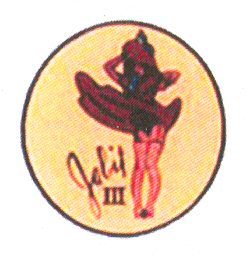Jabit III
| Jabit III | |
|---|---|

| |
| Nose art for Jabit III | |
| Type | Boeing B-29-36-MO Superfortress
|
| Manufacturer | Glenn L. Martin Company |
| Manufactured | Delivered to the USAAF on April 3, 1945 |
| Serial | 44-27303 |
| Radio code | Victor 1, later Victor 71 |
| Owners and operators | United States Army Air Force
|
| In service | April 3, 1945 - 1946 |
| Fate | Scrapped after being damaged in a landing accident |
Jabit III (alternately spelled Jabbitt III [1] Archived 2013-05-01 at the
393d Bomb Squadron, 509th Composite Group, Jabit III was used as a weather reconnaissance aircraft and flew to the city of Kokura
, designated as the secondary target, before the final bombing to determine if conditions were favorable for an attack.
History
One of 15
Wendover Army Air Field, Utah, in April 1945, departing Wendover for North Field, Tinian
on June 5, 1945, arriving on June 11.
Jabit III was originally assigned the Victor (unit-assigned aircraft identification) number 1 but on August 1 was given the
large 'A' tail markings of the 497th Bomb Group as a security measure and had its Victor number changed to 71, to avoid misidentification with actual 497th BG aircraft. Jabit III was used by the group commander, Col. Paul Tibbets, on July 24 and 25 to drop two dummy Little Boy atomic bomb assemblies into the ocean off Tinian to test fire their radar altimeter
components.
In addition to the Hiroshima mission and two test flights, Jabit III was flown by Capt. Wilson and crew B-6 on ten training and practice missions, and three combat missions, dropping
Uwajima. 1st Lt. Ralph Devore and crew A-3 flew Jabit III on a pumpkin bomb mission to Osaka
.
Jabit III and crew B-6 were one of two sent back to Wendover on August 9, 1945, to stage for possibly bringing back the
initiator for a third atomic bomb, but the war ended before that occurred. The aircraft had been unnamed when it left Tinian but was possibly given a name and nose art during its return to the United States. It was damaged in a landing accident in Chicago
on September 29, 1945, while on a training flight and was scrapped in April 1946.
Hiroshima mission crew
Crew B-6 (regularly assigned to Jabit III)
- Capt. John A. Wilson, Aircraft Commander
- 2nd Lt. Ellsworth T. Carrington, Co-Pilot
- 2nd Lt. James S. Duva, Navigator
- 2nd Lt. Paul W. Gruning, Bombardier
- M/Sgt. James W. Davis, Flight Engineer
- S/Sgt. Glen H. Floweree, Radio Operator
- Sgt. Vernon J. Rowley, Radar Operator
- Cpl. Chester A. Rogalski, Tail Gunner
- Cpl. Donald L. Rowe, Assistant Engineer/Scanner
Other aircraft named Jabit III
Two
Pease Air Force Base, New Hampshire
, in the 1970s and 1980s. -7193 was named Jabitt III and -0258 Jabit IV.
Notes
This article includes a improve this article by introducing more precise citations. (August 2009) ) |
Sources
- Campbell, Richard H., The Silverplate Bombers: A History and Registry of the Enola Gay and Other B-29s Configured to Carry Atomic Bombs (2005), ISBN 0-7864-2139-8
- 509th CG Aircraft Page, MPHPA
External links
- Picture of "Jabit III" crew Archived 2011-09-29 at the Wayback Machine
